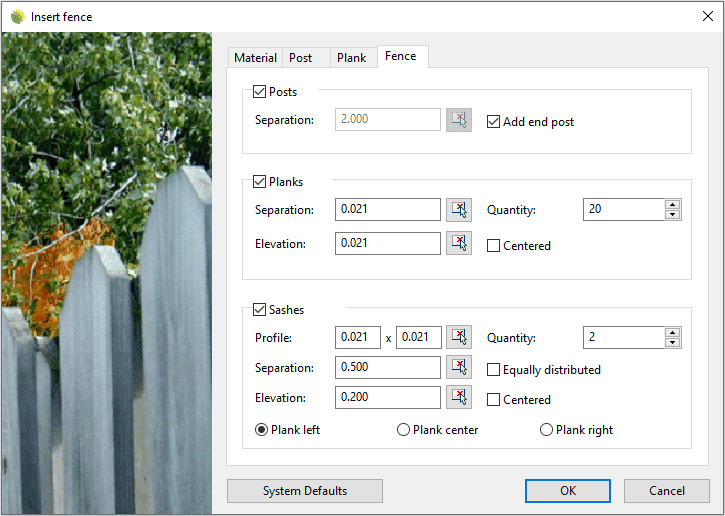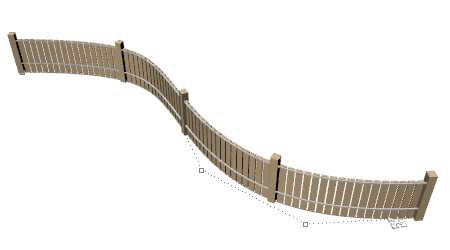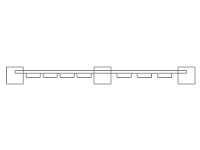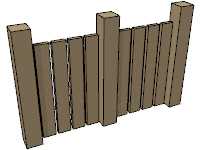Fence
Fences are elements that will be used to divide a garden or park in sectors for different uses.
Fences are defined by the combination of three components that can be added or deleted anytime: Posts, Balusters and Rails.
Insert a fence
After running the laFence command, the Fence insert dialog box will appear. This dialog shows the basic options of the Fence object in different tabs.
- Fence: fence parameters.
- Post: post component parameters.
- Baluster: baluster component parameters.
- Material: material settings for the fence object.
Steps:
- Select the Fence parameters. Click OK to close the dialog
- Pick an existing curve in the model to define the fence path, or select a different option in the command line.
- Polyline: the fence will be created as if you were drawing a polyline.
- Spline: the fence will be created as if you were drawing a spline.
- Circle: the fence will be created as if you were drawing a circle. The first click determines the center of the circle, and the second click determines the radius.
- Arc: the fence will be created as if you were drawing an arc. The first click determines the insert point. The second click determines a middle point in the arc. The third and last click determine where the arc ends.
- Rectangle: the fence will be created as if you were drawing a rectangle. The first click determines one corner of the rectangle and the second click determines the opposite corner.
- Press ENTER, ESC or right click to end the command.
Lands will use the number of posts and balusters required to complete the length of the fence axis, respecting the separation and quantity parameters described above as much as possible.
NoteThe fence can be built without any of the three types of components. However, posts and balusters cannot be omitted at the same time.

Insert dialog box for the Fence object
Control Points 
The Fence object has the same control points as the curves used to generate it.
In addition, it has a Move control arrow, to move the whole object.
Fence control points are automatically enabled when selecting fences one by one. To turn one ore more Fence object control points on just select the fences and run the PointsOn command (or press F10). To turn a Fence object points off, press ESC button or run the PointsOff command.

Control points on Fence objects
Insertion Options and Parameters
The Fence object insert options and parameters are divided in different tabs, and are available from different dialogs:
- Fence insert dialog box (only available when inserting new Fences).
- Fence properties section, in the Lands Design Edit panel.
- Object Properties dialog.
- Properties Explorer dialog.
General
General attributes for the Fence object: Name, Color, Layer, and Transparency (only visible in Conceptual display mode).
Fence
This tab lets you edit the general parameters of the fence components: Posts, Balusters and Rails.
- Posts: they are the main vertical component in a fence. They are placed at the end and start points of a fence path curve and at each one of the discontinuity points in between. They can be distributed in two ways:
- Distance between posts: distance between posts when there are no discontinuity points in between. This parameter affects the baluster Quantity parameter, that is calculated automatically.
- By quantity of balusters: the distance among posts is determined by the baluster quantity setting. This option is only available if the baluster component is enabled.
- Balusters: vertical elements located between the fence posts.
- Separation: gap among balusters when there are no discontinuity points in between.
- Quantity: number of balusters between two posts. This number might not be effective in the last part of the fence, or in fence segments that are too short.
- Elevation: distance between the balusters bottom edge and the fence path curve. The centered option centers the balusters vertically, taking the post height as the reference value.
- Rails: horizontal fence elements that follow the fence path curve.
- Profile: unlike posts and balusters, rails can only have a rectangular profile.
- Quantity: number of rail items in the fence.
- Separation: distance among rails. The option equally distributed sets an equal separation distance among rail elements.
- Elevation: distance between the lower rail element and the fence path curve. The centered option centers the rails vertically, taking the post height as the reference value.
- Alignment: position of rails (Left, Center, Right) in relation to the Post and Baluster component.
Post
This tab appears when the Post component is enabled from the Fence tab. You can define the following parameters:
- Object selection: you can select the geometry for the Post in different ways:
 A block from the Block Library.
A block from the Block Library. A file from your PC
A file from your PC An existing object in the model.
An existing object in the model.
- Dimensions: the post dimensions are automatically calculated from the selected geometry (according to its bounding box dimensions). You can change these dimensions and the object will be scaled accordingly.
- Uniform scale: this option makes the post dimensions change automatically when editing any of its values, in order to preserve the component proportions.
Baluster
This tab appears when the Baluster component is enabled from the Fence tab. You can define the following parameters:
- Object selection: you can select the geometry for the Baluster in different ways:
 A block from the Block Library.
A block from the Block Library. A file from your PC
A file from your PC An existing object in the model.
An existing object in the model.
- Dimensions: the baluster dimensions are automatically calculated from the selected geometry (according to its bounding box dimensions). You can change these dimensions and the object will be scaled accordingly.
- Uniform scale: this option makes the baluster dimensions change automatically when editing any of its values, in order to preserve the component proportions.
Material
This tab lets you change the textured image assigned to this element and define the image size, reflectivity and transparency.
Posts and balusters components will take the fence material if their constituent parts have the material assigned By Parent.
Edit options
These are the edit options for the fence object, available in the Edit area of the Edit panel:
 Update
Update Convert to 2D. Displays the object in 2D representation.
Convert to 2D. Displays the object in 2D representation. Convert to 3D. Displays the object in 3D representation.
Convert to 3D. Displays the object in 3D representation.- Show 2D and 3D: Turns the object 2D and 3D representation on simultaneously.
- Copy properties from another object
- Copy to another curve
- Invert curve
- Extract curve
- Adjust
- Don't adjust to terrain
Fence graphical display
Fence object offers a simultaneous 2D and 3D display on the drawing.

|

|
| 2D | 3D |
 left click
left click